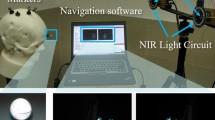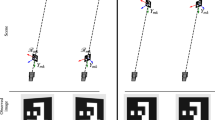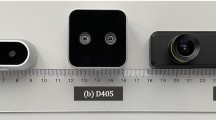Abstract
Virtual and augmented reality surgery calls for reliable and efficient tracking of the surgical instruments in the virtual or real operating theatre. The most diffused approach uses three or more not aligned markers, attached to each instrument and surveyed by a set of cameras. However, the structure required to carry the markers does modify the instrument’s mass distribution and can interfere with surgeon movements. To overcome these problems, we propose here a new methodology, based on structured markers, to compute the six degrees of freedom of a surgical instrument. Two markers are attached on the instrument axis and one of them has a stripe painted over its surface. We also introduce a procedure to compute with high accuracy the markers center on the cameras image, even when partially occluded by the instrument’s axis or by other structures. Experimental results demonstrate the reliability and accuracy of the proposed approach. The introduction of structured passive markers can open new possibilities to accurate tracking, combining markers detection with real-time image processing.







Similar content being viewed by others
References
Ahn SJ, Rauh W, Warnecke H (2001) Least-squares orthogonal distances fitting of circle, sphere, ellipse, hyperbola, and parabola. Patt Recogn 34:2283–2303
Borghese NA, Ferrigno G, Pedotti A (1990) An algorithm for 3D automatic movement analysis means of standard TV cameras. IEEE Trans Biomed Eng 37:1221–1225
Calrontech website, http://www.clarontech.com/measurement_demos.php. Accessed 8 Oct 2012
Cappozzo A, Leo T, Pedotti A (1975) A general computing method for the analysis of human locomotion. J Biomech 8:307–320
Chen TC, Chung KL (2001) An efficient randomized algorithm for detecting circles. Comput Vision Image Underst 83(2):172–191
Chernov N, Lesor C (2005) Least squares fitting of circles. J Math Image Vision 23:239–252
Chiari L, Croce U, Leardini A, Cappozzo A (2005) Human movement analysis using stereophotogrammetry. Part 2: instrumental errors. Gait Posture 21(2):197–211
Colquhoum C (2007) Flexible image guided surgery marker. US Patent 2007(0055232):A1
Comaniciu D, Meer P (2002) Mean shift: a robust approach towards feature space analysis. IEEE Trans PAMI 24(5):603–615
Faugeras O (1993) Three dimensional computer vision. MIT Press, Cambridge
Frosio I, Borghese NA (2008) Real-time accurate circle fitting with occlusions. Patt Recogn 41(3):1041–1055
Frosio I, Pedersini F, Borghese NA (2009) Autocalibration of MEMS accelerometers. IEEE Trans Instr Meas 58(6):2034–2041
Frosio I, Alzati A, Bertolini M, Turrini C, Borghese NA (2012) Linear pose estimate from corresponding conics. Pattern Recogn 45(12):4169–4181
Haque S, Hrinivasan S (2006) A meta-analysis of the training effectiveness of virtual reality surgical simulators. IEEE Trans Inf Tech Biomed 10(1):51–58
Hartley R, Zisserman A (2003) Multiple view Geometry, 2nd edn. Cambridge University Press, Cambridge
Hong J, Matsumoto N, Ouchida R, Komune S, Hashizume M (2009) Medical navigation system for otologic surgery based on hybrid registration and virtual intraoperative computed tomography. IEEE Trans Biom Eng 56(2):426–432
Kosaka A, Saito A, Shibasaki T, Asano T, Matsuzaki H, Furuhashi Y (2004) Three dimensional position and sensing system, US Patent 6,724,930B1
Lanz O (2006) Approximate Bayesian multi-body tracking. IEEE Trans Pattern Anal Mach Intell 28(9):1–14
Northern Digital webstite, http://www.ndigital.com. Accessed 8 Oct 2012
Novotny PM, Stoll JA, Vasilyev NV, del Nido PJ, Dupont PE, Howe RD (2007) GPU based real-time instrument tracking with three dimensional ultrasound. Med Image Anal 11(5):458–464
Patruno F, Aliverti A, Dellacà RL, Burns D, Pedotti A (2005) Redundant system of passive markers for ultrasound scanhead tracking. IEEE Trans Biomed Eng 52(1):88–96
Rabuffetti M, Crenna P, Leardini A (2008) Quantitative comparison of five current protocols in gait analysis. Gait Posture 28(2):207–216
Winter D (2009) Biomechanics and motor control of human movement, 4th edn. Wiley, Chichester
Wolf PR (2000) Elements of photogrammetry, 3rd edn. McGrawHill, New York
Author information
Authors and Affiliations
Corresponding author
Electronic supplementary material
Below is the link to the electronic supplementary material.
Rights and permissions
About this article
Cite this article
Alberto Borghese, N., Frosio, I. Compact tracking of surgical instruments through structured markers. Med Biol Eng Comput 51, 823–833 (2013). https://doi.org/10.1007/s11517-013-1052-7
Received:
Accepted:
Published:
Issue Date:
DOI: https://doi.org/10.1007/s11517-013-1052-7




